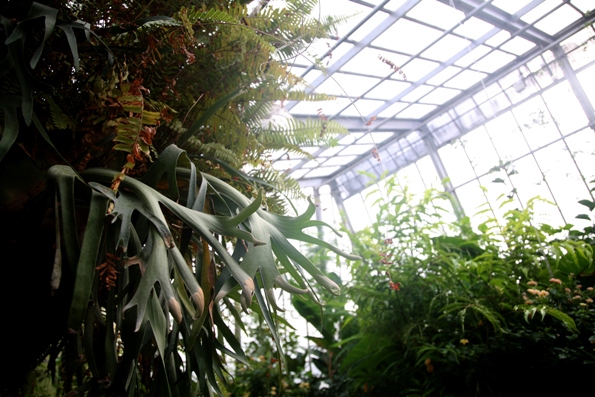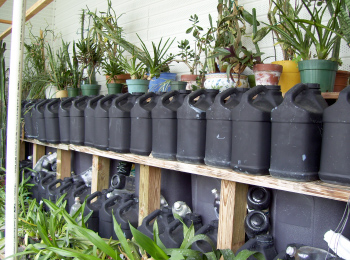
Perhaps the easiest, oldest and most traditional means of heating a greenhouse is with passive solar energy. As the name implies, the heat source is solar energy, and the collection, retention and distribution of heat is passive. It requires no pumps, fans or other active means to take advantage of the solar gain.
The key to good passive solar heating is to design your solar capture system correctly so you maximize capture of energy and minimize losses. It’s also important that you have proper thermal mass in place so you’ll retain as much solar energy for as long as you possibly can – throughout the night – until the sun comes around the next day to “recharge” your system.
The Basic Concepts
In order to understand this a little better, let’s look at several principles and concepts at work here. These are the basics to understanding any type of solar heating system – passive or active. This discussion is arranged in an order that closely follows how the concepts are used in a solar collection system.
Insolation
This is how well we let solar rays enter our capture system. Good insolation comes from having our glazing perpendicular to the sun, having a large amount of glazing, and reducing shadows and other factors that attenuate solar gain. After all, it’s light that makes heat, so let the sun shine through.
Color
Dark colors like black absorb heat quickly, but they also emit heat more readily. Light colors like white resist absorbing heat, and they also resist emitting it once they’ve acquired it.

Thermal Mass
Dense materials that collect and hold heat energy. Water, moist soil and concrete are excellent forms of thermal mass. Generally, the rate at which thermal mass acquires heat is proportional to the rate at which it emits heat, when all other factors are equal.
Heat
Energy in the form of heat is always going to move from a state of higher energy to lower energy, unless there is an input of more heat energy. So, things that heat up will eventually cool off.
Heat Rises
Heat naturally rises easily in air and water because these environments provide for movement that transfers heat, known as convection; air moves freely and so does water. The less dense material rises because it is displaced by cooler material that is denser.
Heat Migrates
In the absence of a freely moving medium, heat will migrate based on the easiest conduction path. Metal conducts heat very well. Water is good conductor of heat. Still air is a poor conductor of heat. Heat can also be radiated to nearby objects without a transfer mechanism like convection and conduction.
Insulation
This is how well we prevent heat energy from escaping once we capture it from our source of light. Good insulation stops convection and conduction, the two biggest factors that will rob heat energy away from our system.
Now, with that out of the way, let’s look at how a passive solar heating system in a greenhouse is typically set up for success.
Typical Passive Solar Heated Greenhouse
With a passive solar greenhouse, we want the heating to operate in largely a passive manner, without any intervention by an operator and without use of mechanical devices. The less we “operate” the system, the more “passive” it truly is.
If we’re going to have a passive solar greenhouse, then we’ll need clean glazing and plenty of it. That is the key to maximizing insolation – gaining heat energy from the sun. Having a clean interior and exterior surface will improve the amount of sun we capture. We’ll also want to orient the glazing as perpendicular as possible to increase solar gain as well. This allows more of the sun’s rays to penetrate instead of being reflected or refracted. Also, the orientation of the greenhouse will make a big difference in solar gain. Orient the length of the greenhouse north and south for greatest summer exposure, east and west for greatest winter exposure.
Thermal mass is the key to retaining heat energy that you’ve captured. Without it, any heat absorbed during the day is quickly lost. Holding the heat inside the greenhouse makes it worthwhile to capture it in the first place, so thermal mass should be employed to the maximum extent possible.
The best material for storing heat energy is water. It can take the form of moist soil, but most often takes the form of large barrels of water, painted black on the side exposed to the sun, and painted white on the opposite side. Usually these barrels are placed on the north wall of the greenhouse so they don’t obstruct sunlight reaching the plants, and they are in a position to catch low hanging sun in the winter months when we need to maximize capture of the sun’s energy.
The black paint on the south-facing side of the barrel facilitates absorption of the sun’s energy. The white north-facing portion of the barrel helps retain energy inside the barrel because of its low emissivity. When the sun is no longer recharging the barrels with heat, the black south-facing side emits heat energy back into the growing space of the greenhouse, through convection and radiation, instead of giving it off to the north wall which would do little good.
In addition or instead of barrels filled with water, we could use large concrete blocks to create a heat-absorbing wall inside the greenhouse on the north side. Again, painting it black would help it absorb heat energy, and the thermal mass of the concrete would help sustain its ability to release heat over the longer term.
Regardless of our main thermal mass in the greenhouse, we’d be well advised to try to isolate that mass with a little insulation so we’re not conducting thermal energy out of the greenhouse because our “thermal battery” is right up against a heat sink like an un-insulated outside wall or bank of soil.
To add a level of insulation to the overall structure, we’d likely make certain that during the night there was little or no in-leakage of air, and little or no means of air to escape the greenhouse and carry with it the thermal energy we’re trying to store and slowly release. For the most part, that means reducing opportunities for convection that are promoted by moving air. So, vents and shutters used to remove excess heat during the day should be sealed up well when not in use.
The main concern that a greenhouse gardener will have with a passive solar greenhouse is to regulate heat absorption during the day. This will require an “active” cooling system. It’s great to get the structure up to temperature and absorbing as much heat as possible, but it’s easy to overdo it, so ventilation must be taken into consideration to keep temperatures at a point where they’re friendly to plant growth and survival, while still maximizing energy gain through use of thermal mass.
So, passive solar heating relies heavily on understanding the basics of how solar energy and thermal energy behave, and then designing a structure and system to maximize solar gain and energy retention.
In the next article in this series, let’s look at how we can help our cause by making use of an active solar energy system – one that gathers and captures solar energy by means that are other than passive in nature. Such a system can be built into the greenhouse or created as a separate facility, or a little of both.
Clair Schwan builds his own greenhouses and creates them with both passive and active solar collection systems. His primary interest is solar collection from late fall to early spring since he enjoys stretching his growing season and taking cold-hardy cultivars into the single digits during the winter months.
Related Articles & Free Email Newsletter
Artificial Light for the Greenhouse
Deciding Between a Lean-To or Attached Greenhouse




Comment here